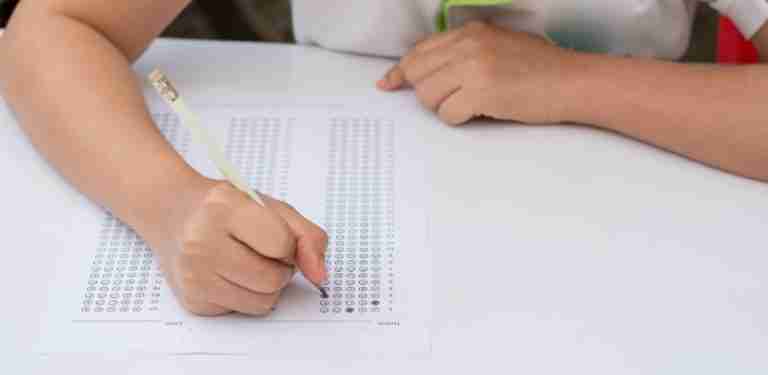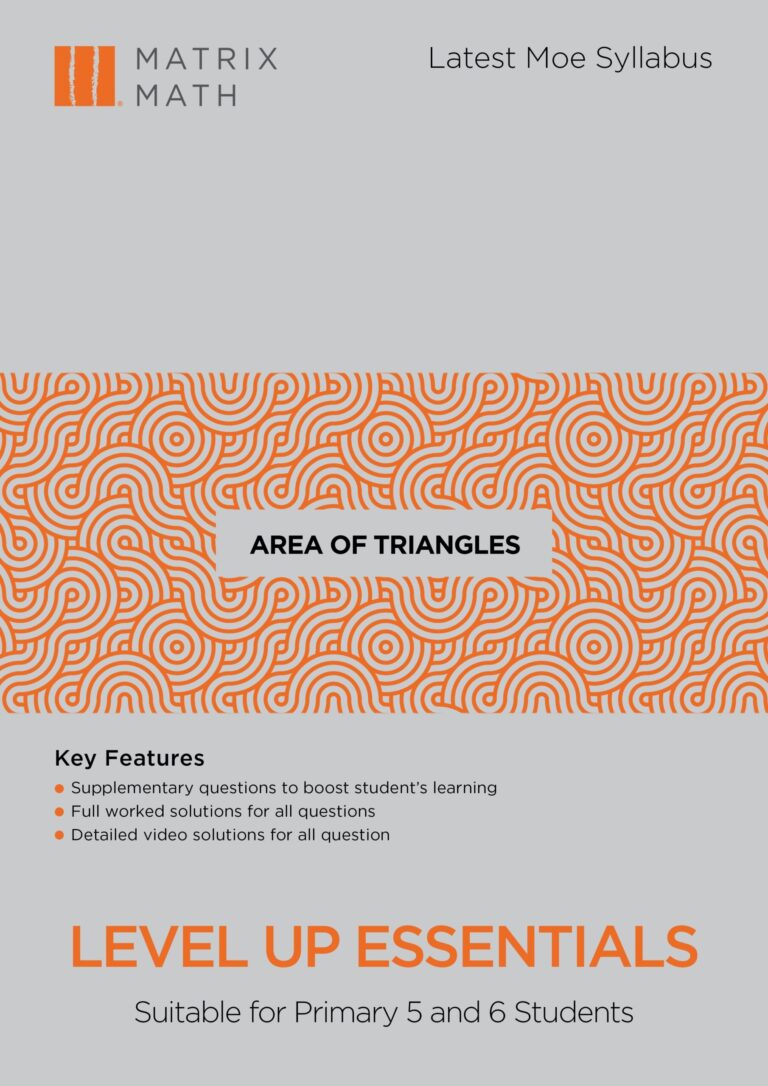PRIMARY MATH
LEARNING TO THINK DIFFERENTLY
Our Primary Maths Tuition Programme is specially designed to equip your child with the essential skills to shine in PSLE maths. We understand that success in PSLE maths goes beyond computational proficiency but depends on your child’s ability to solve problem sums and think critically and independently.
Developed in collaboration with former school teachers and PSLE markers, our programme incorporates a proprietary systematic method for classifying complex heuristic problem sums. This approach simplifies learning, understanding, and revision, ensuring that your child grasps concepts efficiently.

STRUCTURED WORKBOOK PRACTICE
Our workbooks are designed to offer your child the essential practice needed to solve each type of sum step-by-step, nurturing a solid foundation in both understanding and skills. Each of them is structured by grouping mathematics questions according to topics and concepts. Problem sums that demand similar problem-solving approaches are grouped together.
As a result, our students experience continuous growth in confidence with every lesson, transforming into independent and proficient maths learners.
Challenges Students Faced in Primary School When Preparing for PSLE Maths Exam
Complexity: Students may find PSLE Maths challenging when their foundation understanding is weak. This is because the exam builds upon concepts introduced in the previous years of their education.
Critical Thinking: PSLE Maths exam questions often require a deeper understanding of mathematical concepts. For students who have not grasped the fundamentals or relied on rote learning, the exam can be demanding.
Word Problems: PSLE Maths questions demand reading comprehension and the ability to apply math concepts in real-life contexts, which can be difficult for some students.
Benefits of Primary Math Tuition
Personalised attention and feedback: Maths tuition provides smaller class sizes or one-to-one sessions, allowing tutors to focus on each child’s specific needs.
Enhanced Confidence and Motivation: A strong learning foundation helps students overcome anxiety, boosting their confidence as they master previously challenging concepts.
Efficient preparation for exams: We provide structured workbook practice and mock exam to guide students as they progress through topics and concepts.
Improved Problem-Solving Skills: Students are able to learn to break down complex problems into manageable steps, identify relevant information, and apply the appropriate solutions.
80% OF PSLE MATHS QUESTIONS DEMAND PROBLEM-SOLVING SKILLS AND TECHNIQUES.
Achieving an AL1 in PSLE Maths requires an integrated approach right from the start. Over the past decade, the Singapore Primary Maths syllabus has transformed, emphasising Applications and Analyses through Heuristic Problem-Solving rather than focusing solely on Mathematics Operations.
By gradually developing essential Primary maths skills through our proprietary Matrix Method approach, your child will be well-equipped to confidently tackle these types of questions in the PSLE. Prepare them for success by laying a strong foundation early on and watch their mathematical achievements soar.

THE MATRIX METHOD THOUGHT PROCESS BREAKS PROBLEM SOLVING INTO 5 SIMPLE STEPS:

Record Data

Establish A Common Base

Identify The Value

Solve 1 Unit

Read The Question Again
Singapore Primary Mathematics Syllabus (Primary 1 to 6)
The following table summarises the key concepts and skills in the Singapore Primary Mathematics Syllabus (2021) for Primary 1 to Primary 6, covering both Standard and Foundation levels. The syllabus is organized into three content strands: Number and Algebra, Measurement and Geometry, and Statistics. Note that in 2025, Primary 6 students follow the 2013 syllabus, with the 2021 syllabus applying to Primary 6 from 2026.
Primary 1
Number and Algebra
– Whole numbers up to 100: counting, place values, comparing, ordering, patterns, ordinal numbers
– Addition and subtraction within 100, including mental calculations
– Multiplication and division within 40 and 20, respectively
– Money: counting cents up to $1, dollars up to $100
Measurement and Geometry
– Length: measuring in cm, comparing, ordering
– Time: telling time to 5 minutes, using am/pm, duration
– 2D Shapes: identifying, naming, classifying (e.g., rectangle, circle), forming/copying figures
Statistics
– Picture graphs: reading and interpreting data
Primary 2
Number and Algebra
– Whole numbers up to 1000: counting, place values, comparing, ordering, odd/even numbers
– Addition and subtraction up to 3 digits, mental calculations
– Multiplication and division within tables of 2, 3, 4, 5, 10
– Fractions: part of a whole, comparing/ordering unit and like fractions (denominators ≤ 12)
– Money: dollars and cents, decimal notation, comparing
Measurement and Geometry
– Length, mass, volume: measuring in m, kg/g, liters, comparing
– Time: telling time to the minute, converting hours/minutes
– 2D/3D Shapes: patterns with 2D shapes, identifying 3D shapes (e.g., cube, sphere)
Statistics
– Picture graphs with scales: reading and interpreting data
Primary 3
Number and Algebra
– Whole numbers up to 10,000: counting, place values, comparing, ordering
– Addition and subtraction up to 4 digits, mental calculations
– Multiplication and division within tables of 6, 7, 8, 9, up to 3 digits by 1 digit
– Fractions: equivalent fractions, simplest form, comparing unlike fractions, addition/subtraction
– Money: adding/subtracting in decimal notation
Measurement and Geometry
– Length, mass, volume: measuring in km, ml, compound units, conversions
– Time: seconds, 24-hour clock, finding start/end times
– Area and perimeter: square units (cm², m²), rectangle/square
– Geometry: angles (right, greater/less), perpendicular/parallel lines
Statistics
– Bar graphs: reading, interpreting, using different scales
Primary 4
Number and Algebra
– Whole numbers up to 100,000: place values, rounding, factors/multiples
– Four operations: multiplication (up to 4 digits by 1 digit, 3 digits by 2 digits), division (up to 4 digits by 1 digit)
– Fractions: mixed numbers, improper fractions, fraction of a set, addition/subtraction
– Decimals: up to 3 decimal places, comparing, converting to fractions, four operations
Measurement and Geometry
– Area and perimeter: rectangles, squares, composite figures
– Geometry: angles (naming, measuring, drawing), properties of rectangles/squares, line symmetry, nets of 3D solids (e.g., cube, prism)
Statistics
– Tables, line graphs, pie charts: completing tables, reading/interpreting data
Primary 5 (Standard)
Number and Algebra
– Whole numbers up to 10 million, four operations (including brackets, order of operations)
– Fractions: division, four operations with mixed numbers and fractions
– Decimals: four operations, conversions for measurements
– Percentage: expressing parts as %, finding parts, discounts, GST, interest
– Rate: calculating rate, total amount, or units
Measurement and Geometry
– Area and volume: triangle area, volume of cube/cuboid, liquid volume
– Geometry: angles (straight line, point, vertically opposite), properties of triangles (e.g., isosceles), parallelogram, rhombus, trapezium
Primary 5 (Foundation)
Number and Algebra
– Whole numbers up to 10 million: comparing, rounding, four operations, factors/multiples
– Fractions: concepts, equivalent fractions, mixed numbers, four operations
– Decimals: up to 3 decimal places, four operations, measurement conversions
– Rate: calculating rate, total amount, or units
Measurement and Geometry
– Time: hours/minutes, 24-hour clock, finding start/end times
– Area and perimeter: rectangles, squares, composite figures
– Volume: cube/cuboid, drawing on isometric grid
– Geometry: perpendicular/parallel lines, angles, properties of rectangles/squares
Statistics
– Tables, bar graphs, line graphs: reading, interpreting, completing tables
Primary 6 (Standard)
Number and Algebra
– Fractions: division of fractions
– Percentage: finding whole, percentage increase/decrease
– Ratio: notation (a:b, a:b:c), equivalent ratios, dividing quantities
– Algebra: simple linear expressions, equations with whole number coefficients
Measurement and Geometry
– Area and circumference: circle, semicircle, quarter circle, composite figures
– Volume: cube/cuboid dimensions
– Geometry: finding angles in composite figures (e.g., square, trapezium)
Statistics
– Average: calculating average, relationship with total value and number of data
Primary 6 (Foundation)
Number and Algebra
– Fractions: division, expressing as decimals, four operations
– Decimals: multiplication, division, rounding
– Percentage: expressing parts as %, finding parts, discounts, GST, interest
Measurement and Geometry
– Area: triangle, composite figures
– Volume: cube/cuboid, liquid volume
– Geometry: properties of triangles, finding angles in composite figures
Statistics
– Pie charts: reading and interpreting
– Average: calculating average, relationship with total value and number of data
Level Up Essentials (Area of Triangles)
Targeted Practice for Area of Triangles (P5 & P6)

“Level Up Essentials” Area of Triangles is a focused drill book designed to help Primary 5 and 6 students build confidence and competence in one of the most frequently tested geometry topics. Every concept in this book has been carefully selected based on past exam trends and school assessments, reflecting the styles and variations students are most likely to encounter.
Questions are organised by concept and targeted skills, enabling students to progress from foundational understanding to more advanced applications. This book is ideal for reinforcing your child’s learning through a structured and comprehensive self-paced approach.
The package includes fully worked solutions and step-by-step video explanations for every question, empowering students to review and learn independently.
Price at $18 includes:
- 40 page Assessment book
- Full worked and video solution
- A substantial 40 pages of carefully selected common examination questions and concepts.
- Organised by concepts and skills to aid in gradual learning and mastery.
- A full worked solutions and step-by-step video explanation for all questions for independent learning.
- Tailored to help students excel in their examinations.
Whatsapp us at 9722 7759 to indicate interest in purchase and we will respond to you as soon as we can.

